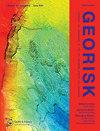Impact of rising sea levels on future Nankai–Tonankai earthquake tsunamis: a case study of Osaka, Japan
IF 4.8
3区 工程技术
Q1 ENGINEERING, GEOLOGICAL
Georisk-Assessment and Management of Risk for Engineered Systems and Geohazards
Pub Date : 2022-09-12
DOI:10.1080/17499518.2022.2119256
引用次数: 3
Abstract
ABSTRACT The present study aims to clarify the impact of future sea level rise (SLR) on the anticipated Nankai–Tonankai earthquake tsunami, using Osaka, Japan as the study area. A total of 110 simulations were performed, incorporating 11 tsunami source models, five sea levels and the presence or absence of coastal defences. The simulated results indicated that while maximum nearshore tsunami heights would increase by almost the same magnitude as the rising sea level, changes in the maximum inundation depth, depth-velocity product and momentum flux over land did not reveal simple relationships to sea levels. In addition, if Osaka’s seawalls immediately failed due to the ground shaking transmitted by the earthquake, it was estimated that around 38,000 buildings and 58,000 people would be affected by the tsunami at present (for SLR +0 m), rising to around 120,000 buildings and 150,000 people in the future. In contrast, if they survived the ground shaking, the number of affected buildings and people were shown to be significantly lower, with 7,000 buildings and 18,000 people for SLR +1.0 m. It is thus essential for Osaka to maximise the resilience of the current coastal defence system and property maintain them into the near future.海平面上升对未来南开-东海地震海啸的影响——以日本大阪为例
摘要本研究以日本大阪为研究区,探讨未来海平面上升对南开-东南开地震海啸的影响。总共进行了110次模拟,包括11个海啸源模型、5个海平面和海岸防御的存在与否。模拟结果表明,虽然最大近岸海啸高度的增加幅度与海平面上升幅度几乎相同,但最大淹没深度、深速积和陆地动量通量的变化与海平面的关系并不简单。此外,如果大阪的海堤因地震传播的地面震动而立即失效,预计目前(SLR +0 m)约有38,000栋建筑和58,000人受到海啸的影响,未来将增加到约120,000栋建筑和150,000人。相比之下,如果他们在地面震动中幸存下来,那么受影响的建筑物和人数就会明显减少,SLR +1.0 m的建筑物和人数为7000人,人数为18000人。因此,大阪必须最大限度地提高现有海防系统的弹性,并在不久的将来保持它们的财产。
本文章由计算机程序翻译,如有差异,请以英文原文为准。
求助全文
约1分钟内获得全文
求助全文
来源期刊
CiteScore
8.70
自引率
10.40%
发文量
31
期刊介绍:
Georisk covers many diversified but interlinked areas of active research and practice, such as geohazards (earthquakes, landslides, avalanches, rockfalls, tsunamis, etc.), safety of engineered systems (dams, buildings, offshore structures, lifelines, etc.), environmental risk, seismic risk, reliability-based design and code calibration, geostatistics, decision analyses, structural reliability, maintenance and life cycle performance, risk and vulnerability, hazard mapping, loss assessment (economic, social, environmental, etc.), GIS databases, remote sensing, and many other related disciplines. The underlying theme is that uncertainties associated with geomaterials (soils, rocks), geologic processes, and possible subsequent treatments, are usually large and complex and these uncertainties play an indispensable role in the risk assessment and management of engineered and natural systems. Significant theoretical and practical challenges remain on quantifying these uncertainties and developing defensible risk management methodologies that are acceptable to decision makers and stakeholders. Many opportunities to leverage on the rapid advancement in Bayesian analysis, machine learning, artificial intelligence, and other data-driven methods also exist, which can greatly enhance our decision-making abilities. The basic goal of this international peer-reviewed journal is to provide a multi-disciplinary scientific forum for cross fertilization of ideas between interested parties working on various aspects of georisk to advance the state-of-the-art and the state-of-the-practice.

 求助内容:
求助内容: 应助结果提醒方式:
应助结果提醒方式:


